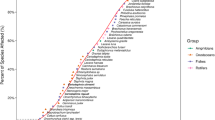Abstract
The acute (12 h) and chronic (7 or 14 d) effects of tributyltin chloride (TBT) on a new type of test fish, the Chinese rare minnow (Gobiocypris rarus), have been studied. High accumulation of the pollutant in the fish muscle and obvious changes in hepatosomatic index and gonad somatic index were observed after exposure. The ultrastructural findings show a series of pathological changes existing in the exposed gill cells and hepatocytes, which demonstrates the toxicity effects of tributyltin compounds on aquatic organisms. The results clearly show that the Chinese rare minnow is a new sensitive test fish material, whose exposure system is suitable for the extensive organometallic toxicity studies.
Similar content being viewed by others
References
Maguire, R. J., Carey, J. H., Hale, E. J., Degradation of the tri-n-butyltin species in water, J. Agrie. Food Chem., 1983, 31: 1060–1065.
Hall, L. W. Jr., Pinkney, A. E., Acute and sublethal effects of organotin compounds on aquatic biota: an interpretative literature evaluation, Crit. Rev. Toxicol., 1985, 14: 159–209.
Bryan, G. W., Gibbs, P. E., Hummerstone, L. G et al., The decline of the gastropod Nucella lapillus around south-west England: Evidence for the effect of tributyltin from antifouling paints, J. Mar. Biol. Ass. UK, 1986, 66: 611–640.
Rita, T., Heinz-Rudiger, K., Jurgen, F. et al., Evaluation of bis(tri-n-butyltin)oxide (TBTO) neurotoxicity in rainbow trout (Oncorhynchus mykiss), I. Behaviour, weight increase, and tin content, Aquat. Toxicol., 1994, 30: 189–197.
Jeffrey, W. S., Frank, P. T., Toxicity of tri-n-butyltin to Chinook Salmon, Oncorhynchus tshawytscha, adapted to seawater, Aquaculture, 1987, 61: 193–200.
Wang, J., Cao, W., Gobiocypris rarus and fishes as laboratory animals, Transactions of the Chinese Ichthyological Society, 1997,6: 144–152.
Bryan, G W., Gibbs, P. E., Burt, G R., A comparison of the effectiveness of tri-n-butyltin chloride and five other organotin compounds in promoting the development of imposex in the dog-whelk Nucella lapillus, J. Mar. Biol. Assoc. UK, 1988, 68: 733–744.
Smith, B. S., Tributyltin compounds induce male characteristics on female mud snails Nassarius obsoletus = Ilyanassa obsoleta, J. Appl. Toxicol., 1981, 1: 141–144.
Oehlmann, J., Schulte-Oehlmann, U., Stroben, E. et al., Androgenic effects of organotin compounds in molluscs, Expert Round. Endocrinically Active Chemicals in the Environment, UBA-Texte, 1996, 3: 111–118.
Schwaiger, J., Bucher, F., Ferling, H. et al., A prolonged toxicity study on the effects of sublethal concentrations of bis(tri-n-butyltin)oxide (TBTO): histopathological and histochemical findings in rainbow trout (Oncorhynchus mykiss), Aquat. Toxicol., 1992, 23: 31–48.
Wester, P. W., Canton, J. H., Histopathological study of Poecilia reticulaia (guppy) after long-term exposure to bis(tri-n-butyltin)oxide (TBTO) and di-n-butyltindichloride (DBTC), Aquat. Toxicol., 1987, 10: 143–165.
Wester, P. W., Canton, J. H., VanIersel, A. A. J. et al., The toxicity of bis(tri-n-butyltin)oxide (TBTO) and di-n-butyltindichloride (DBTC) in the small fish species Oryzias latipes (medaka) and Poecilia reticulata (guppy), Aquat. Toxicol., 1990, 16: 53–72.
Braunbeck, T., Cytological alterations in isolated hepatocyte from rainbow induced by 4-chloroaniiline, Aquat. Toxicol., 1992, 22: 57–65.
Rita, T., Heinz-Rudiger, K., Karl-Heinz, et al., Evaluation of bis(tri-n-butyltin)oxide (TBTO) neurotoxicity in rainbow trout (Oncorhynchus mykiss), I. Ultrastructural diagnosis and tin localization by energy filtering transmission eledtron mi- croscopy (EFTEM), Aquat. Toxicol., 1994, 30: 199–213.
Karl, F., Embryotoxic effects of tributyltin on the minnow Phoxinus phoxinus, Environ. Pollut, 1992, 76: 187–194.
Author information
Authors and Affiliations
Corresponding author
Rights and permissions
About this article
Cite this article
Zhou, Q., Jiang, G. & Liu, J. Acute and chronic effects of tributyltin on the Chinese rare minnow (Gobiocypris rarus). Sc. China Ser. B-Chem. 46, 243–251 (2003). https://doi.org/10.1360/02yb0262
Received:
Issue Date:
DOI: https://doi.org/10.1360/02yb0262




